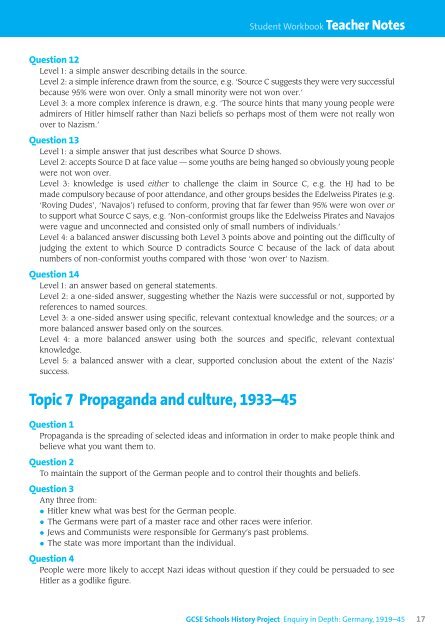GCSE Schools History Project Enquiry in Depth - Hodder Plus Home
GCSE Schools History Project Enquiry in Depth - Hodder Plus Home
GCSE Schools History Project Enquiry in Depth - Hodder Plus Home
You also want an ePaper? Increase the reach of your titles
YUMPU automatically turns print PDFs into web optimized ePapers that Google loves.
Student Workbook Teacher NotesQuestion 12Level 1: a simple answer describ<strong>in</strong>g details <strong>in</strong> the source.Level 2: a simple <strong>in</strong>ference drawn from the source, e.g. ‘Source C suggests they were very successfulbecause 95% were won over. Only a small m<strong>in</strong>ority were not won over.’Level 3: a more complex <strong>in</strong>ference is drawn, e.g. ‘The source h<strong>in</strong>ts that many young people wereadmirers of Hitler himself rather than Nazi beliefs so perhaps most of them were not really wonover to Nazism.’Question 13Level 1: a simple answer that just describes what Source D shows.Level 2: accepts Source D at face value — some youths are be<strong>in</strong>g hanged so obviously young peoplewere not won over.Level 3: knowledge is used either to challenge the claim <strong>in</strong> Source C, e.g. the HJ had to bemade compulsory because of poor attendance, and other groups besides the Edelweiss Pirates (e.g.‘Rov<strong>in</strong>g Dudes’, ‘Navajos’) refused to conform, prov<strong>in</strong>g that far fewer than 95% were won over orto support what Source C says, e.g. ‘Non-conformist groups like the Edelweiss Pirates and Navajoswere vague and unconnected and consisted only of small numbers of <strong>in</strong>dividuals.’Level 4: a balanced answer discuss<strong>in</strong>g both Level 3 po<strong>in</strong>ts above and po<strong>in</strong>t<strong>in</strong>g out the difficulty ofjudg<strong>in</strong>g the extent to which Source D contradicts Source C because of the lack of data aboutnumbers of non-conformist youths compared with those ‘won over’ to Nazism.Question 14Level 1: an answer based on general statements.Level 2: a one-sided answer, suggest<strong>in</strong>g whether the Nazis were successful or not, supported byreferences to named sources.Level 3: a one-sided answer us<strong>in</strong>g specific, relevant contextual knowledge and the sources; or amore balanced answer based only on the sources.Level 4: a more balanced answer us<strong>in</strong>g both the sources and specific, relevant contextualknowledge.Level 5: a balanced answer with a clear, supported conclusion about the extent of the Nazis’success.Topic 7 Propaganda and culture, 1933–45Question 1Propaganda is the spread<strong>in</strong>g of selected ideas and <strong>in</strong>formation <strong>in</strong> order to make people th<strong>in</strong>k andbelieve what you want them to.Question 2To ma<strong>in</strong>ta<strong>in</strong> the support of the German people and to control their thoughts and beliefs.Question 3Any three from:• Hitler knew what was best for the German people.• The Germans were part of a master race and other races were <strong>in</strong>ferior.• Jews and Communists were responsible for Germany’s past problems.• The state was more important than the <strong>in</strong>dividual.Question 4People were more likely to accept Nazi ideas without question if they could be persuaded to seeHitler as a godlike figure.<strong>GCSE</strong> <strong>Schools</strong> <strong>History</strong> <strong>Project</strong> <strong>Enquiry</strong> <strong>in</strong> <strong>Depth</strong>: Germany, 1919–4517
















